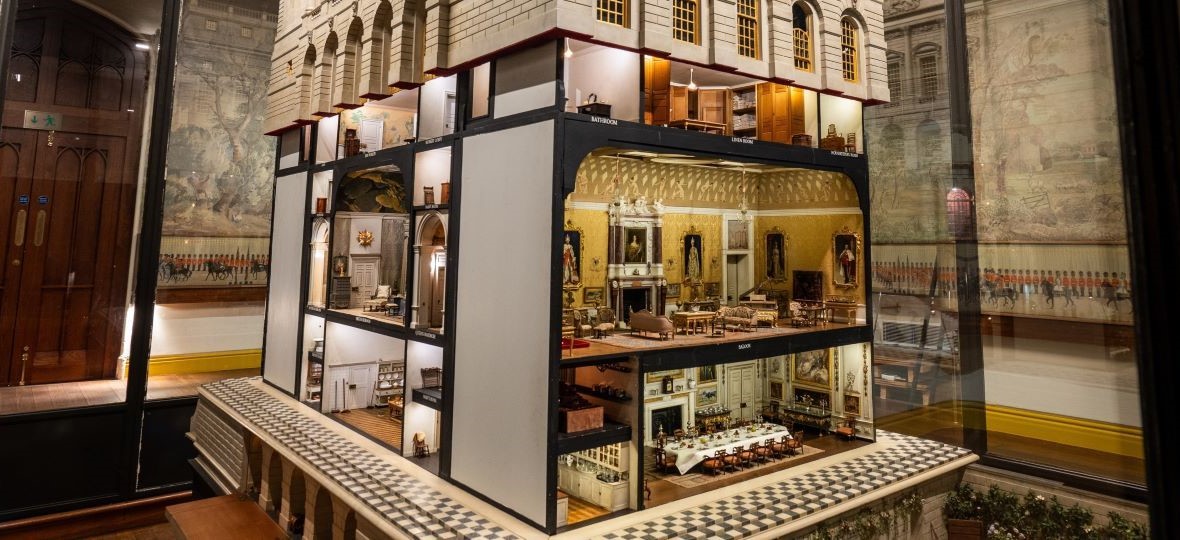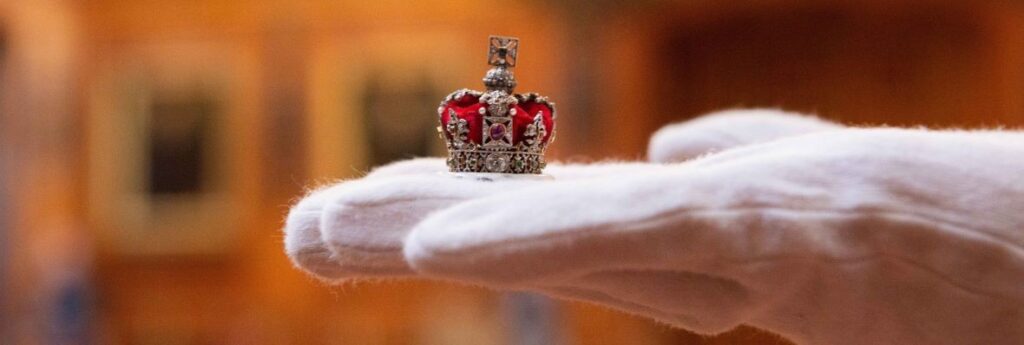Throughout 2024, Britian’s Royal Collection Trust will celebrate the 100th anniversary of Queen Mary’s Dolls’ House at Windsor Castle, the largest and most famous dolls’ house in the world. Queen Mary’s Dolls’ House was built between 1921 and 1924 as a gift from the nation to Queen Mary following the First World War.
It is a perfect 1:12 scale replica of an Edwardian residence, complete with electricity, working lifts and running water. Its scaled-down rooms range from a fully stocked wine cellar and ‘below-stairs’ spaces to grand entertaining salons, and feature contributions from over 1,500 of the finest artists, craftspeople, and manufacturers of the day. The house went on display at Windsor Castle in 1925 and has been delighting visitors ever since.
This year, visitors to the Castle will see a special centenary display of items usually contained within the Dolls’ House, staged in the magnificent Waterloo Chamber. These range from a tiny concert grand piano, fully strung and with functioning keys, to miniature Crown Jewels inset with real diamonds, rubies, sapphires, emeralds, and seed pearls. Items from the kitchens and servants’ quarters include a vacuum cleaner, which was a relatively new innovation in the 1920s; a sewing machine, complete with thread and minuscule scissors that can actually cut; and a copper kettle made from a coin, with the King’s head still visible on its base.
The display allows visitors to get even closer to these tiny treasures and appreciate the extraordinary attention to detail that the craftspeople involved lavished on every miniature item.
Kathryn Jones, curator of the special display, said: “Queen Mary’s Dolls’ House is a constant source of fascination for visitors to Windsor Castle, as irresistible to adults as it is to children. We are thrilled that we can bring the tiny treasures of the Dolls’ House to a wider audience in this anniversary year.”
The room at Windsor Castle that was created to house the Dolls’ House almost 100 years ago has also been re-presented to mark the anniversary. Designed by the house’s architect, Sir Edwin Lutyens, it features murals by the decorative landscape artist Philip Connard together with the artists Dorothy Cohen and Winifred Hardman. These murals have been expertly restored and re-lit, so that visitors can appreciate the fine-detailed scenes of elegantly dressed figures promenading and relaxing in the grounds of a series of royal residences, including Windsor Castle, Buckingham Palace and Hampton Court.
The Dolls’ House itself has been re-lit to simulate daylight rather than moonlight, and the room’s ornate corner niches have been restored and filled with miniature plants and flowers, which were originally created as part of a seasonal scheme for the Dolls’ House Garden.
On Royal Collection Trust’s website, new content will allow as many people as possible around the world to discover the house’s miniature marvels and join the centenary celebrations. For the first time, the house has been filmed from a ‘dolls’ eye view’ perspective, giving viewers the chance to explore rooms including the Queen’s Bedroom, Library, Kitchen, and Day Nursery in closer detail than ever before.

Library
One of the great wonders of the Dolls’ House is its Library, which captured the literary culture of the 1920s through miniature books penned by the era’s foremost writers, from Sir Arthur Conan Doyle and Vita Sackville-West to A. A. Milne and Thomas Hardy. The new publication The Miniature Library of Queen Mary’s Dolls’ House by Elizabeth Clark Ashby, available from today, explores the stories behind the creation of the Dolls’ House Library. The book includes a foreword by Queen Elizabeth, as well as a excerpts from selected works – some of which are reproduced for the first time.
In addition, Lucinda Lambton’s authoritative history of the Dolls’ House, first published in 2010, has been redesigned with newly photographed images to mark the anniversary. The books join a new Queen Mary’s Dolls’ House souvenir range that is available in Royal Collection Trust’s shops.
Anniversary events and activities will take place throughout the year will include a Dolls’ House-themed family trail for visitors.
Admission to Queen Mary’s Dolls’ House and the special display is included in a visit to Windsor Castle, which is open to visitors Thursday to Monday, remaining closed on Tuesdays and Wednesdays.
The Royal Collection is among the largest and most important art collections in the world, and one of the last great European royal collections to remain intact. It comprises almost all aspects of the fine and decorative arts, and is spread among some 15 royal residences and former residences across the UK, most of which are regularly open to the public.

